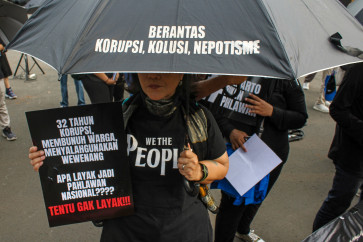Deposit market concentration and interest rate
The history of Indonesiaâs financial system is dominated by the story of the banking system
Change text size
Gift Premium Articles
to Anyone

T
/span>
The history of Indonesia's financial system is dominated by the story of the banking system. From the beginning of its development, banks ' especially state-owned banks (SOBs) have been the dominant players in Indonesia financial sector.
This tendency has persisted until today. Indonesia's financial system undoubtedly can be classified as a so-called 'intermediary based financial system'.
This is taken to mean that booms and busts in the economic business cycle are mainly rooted in how funds are channeled into the economy by the banking system.
The Indonesia banking sector is dominated by commercial banks.
The domination of the banks in the Indonesian financial sector is not the only potential problem.
Within the banking industry itself, there is another kind of domination.
As of December 2014, the four biggest banks accounted for around 44 percent of the industry's total assets and 15 major banks accounted for the majority of the whole industry.
It is not surprising that the four biggest banks also dominated the credit (42 percent) and deposit (47 percent) market. In theory, and confirmed by empirical research, market concentration leads to (tacit) collusion by banks that further leads to high interest rates in the credit market.
Yet, it is somehow problematic for authorities to control the monopoly power wielded by banks as a concentrated market provides stability in the industry and consequently to the financial system as a whole.
That is probably why we never see and expect Bank Indonesia to intervene or restructure the nation's banking industry. It is even worse for the Indonesian economy that on the supply side of funds, the concentrated banking industry has been facing a highly concentrated deposit market.
In December 2015, 0.57 percent or as many as 984,392 bank accounts accounted for around 70.6 percent of the total third-party funds in commercial banks (Table 1).
Under such conditions, commercial banks largely depend on these depositors for sources of funds. While there are many individuals and firms classified as big depositors, it is publicly known that few of them are state-owned enterprises.
Most Indonesian commercial banks classify depositors who have more than Rp 500 million as priority banking depositors (priority or premium customers).
Since banks compete avidly with each other in this very captive deposit market, they give prime depositors high interest rates and even provide non-interest benefits such as extra services.
At the same time, prime depositors also have the power to ask for such high deposit rates and extra services.
Further, this concentrated deposit and credit market is one of the main reasons why Bank Indonesia's monetary policy per se is ineffective in pushing interest rates down.
Another implication of the highly concentrated deposit market is what is referred to as regressive transfers from ordinary savers to prime depositors. This means that banks will pay low interest rates and charge high service fees ' relative to their savings ' to small savers.
___________________________________
The concentrated banking industry has been facing a highly concentrated deposit market.
They will also charge high interest rates to debtors. By implementing such policies, banks cover costs or expenses that occur in parts for servicing prime depositors.
There are probably tens of millions of savers or depositors that have only Rp 1 million in their accounts, against only a few thousand premium or big depositors.
In addition, such relatively high service fees for small savers have become one of factors that hinders people with low incomes to open bank accounts (World Bank, 2010). It further weakens government policy on financial inclusion.
Therefore, it is crucial for the authorities to manage and control the concentration of the deposit market, especially bank practices and the treatment of prime depositors.
____________________________________
The writer is a researcher at the Institute for Economic and Social Research (LPEM-FEB UI), School of Economics, University of Indonesia.









